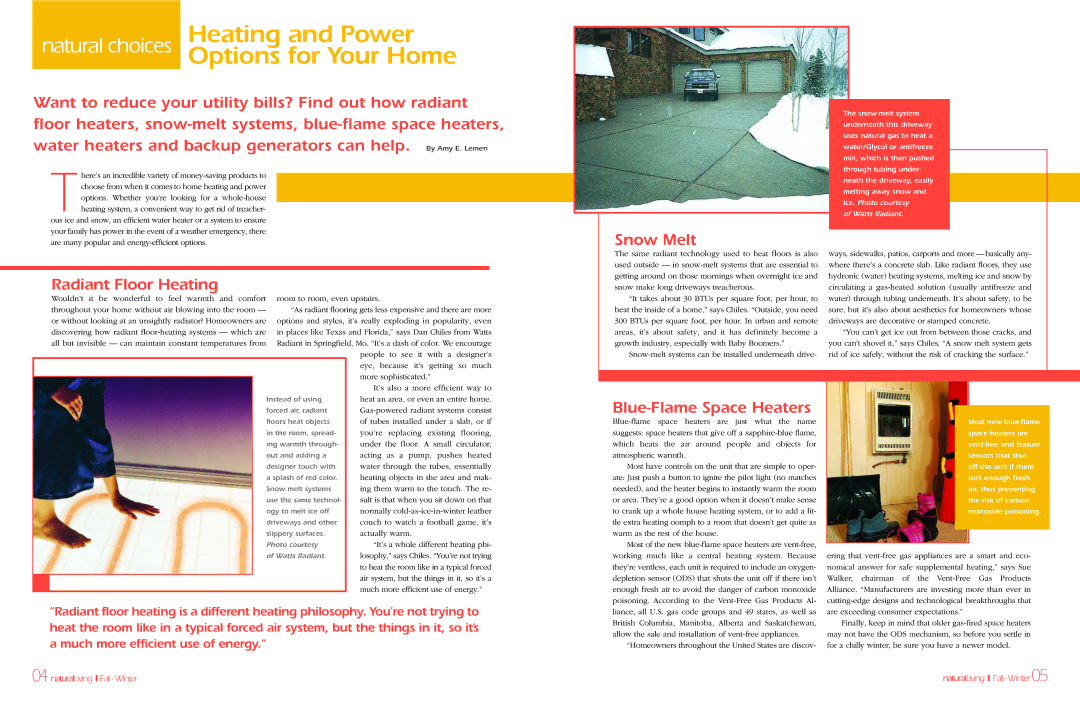Instead of using forced air, radiant floors heat objects in the room, spread- ing warmth through- out and adding a designer touch with a splash of red color. Snow melt systems use the same technol- ogy to melt ice off driveways and other slippery surfaces. Photo courtesy
of Watts Radiant.
By Amy E. Lemen
natural choices Heating and Power Options for Your Home
Want to reduce your utility bills? Find out how radiant floor heaters, snow-melt systems, blue-flame space heaters, water heaters and backup generators can help.
here’s an incredible variety of money-savingproductsto Tchoose from when it comes to home heatingand power options. Whether you’re looking for a whole-house heating system, a convenient way to get rid of treacher-
The snow-melt system underneath this driveway uses natural gas to heat a water/Glycol or antifreeze mix, which is then pushed through tubing under-
neath the driveway, easily melting away snow and ice. Photo courtesy
of Watts Radiant.
ous ice and snow, an efficientwater heater or a system to ensure your family has power in the event of a weather emergency,there are many popular and energy-efficient options.
Radiant Floor Heating
Snow Melt
The same radiant technology used to heat floors is also used outside — in snow-melt systems that are essential to getting around on those mornings when overnight ice and snow make long driveways treacherous.
ways, sidewalks, patios, carports and more — basically any- where there’s a concrete slab. Like radiant floors, they use hydronic (water) heating systems, melting ice and snow by circulating a gas-heated solution (usually antifreeze and
Wouldn’t it be wonderful to feel warmth and comfort throughout your home without air blowing into the room — or without looking at an unsightly radiator? Homeowners are discovering how radiant floor-heating systems — which are all but invisible — can maintain constant temperatures from
room to room, even upstairs.
“As radiant flooring gets less expensive and there are more options and styles, it’s really exploding in popularity, even in places like Texas and Florida,” says Dan Chiles from Watts Radiant in Springfield, Mo. “It’s a dash of color. We encourage people to see it with a designer’s eye, because it’s getting so much
more sophisticated.”
“It takes about 30 BTUs per square foot, per hour, to heat the inside of a home,” says Chiles. “Outside, you need 300 BTUs per square foot, per hour. In urban and remote areas, it’s about safety, and it has definitely become a growth industry, especially with Baby Boomers.”
Snow-melt systems can be installed underneath drive-
water) through tubing underneath. It’s about safety, to be sure, but it’s also about aesthetics for homeowners whose driveways are decorative or stamped concrete.
“You can’t get ice out from between those cracks, and you can’t shovel it,” says Chiles. “A snow melt system gets rid of ice safely, without the risk of cracking the surface.”
It’s also a more efficient way to heat an area, or even an entire home. Gas-powered radiant systems consist of tubes installed under a slab, or if you’re replacing existing flooring, under the floor. A small circulator, acting as a pump, pushes heated water through the tubes, essentially heating objects in the area and mak- ing them warm to the touch. The re- sult is that when you sit down on that normally cold-as-ice-in-winter leather couch to watch a football game, it’s actually warm.
“It’s a whole different heating phi- losophy,” says Chiles. “You’re not trying to heat the room like in a typical forced air system, but the things in it, so it’s a much more efficient use of energy.”
Blue-Flame Space Heaters
Blue-flame space heaters are just what the name suggests: space heaters that give off a sapphire-blue flame, which heats the air around people and objects for atmospheric warmth.
Most have controls on the unit that are simple to oper- ate: Just push a button to ignite the pilot light (no matches needed), and the heater begins to instantly warm the room or area. They’re a good option when it doesn’t make sense to crank up a whole house heating system, or to add a lit- tle extra heating oomph to a room that doesn’t get quite as warm as the rest of the house.
Most of the new blue-flame space heaters are vent-free, working much like a central heating system. Because they’re ventless, each unit is required to include an oxygen- depletion sensor (ODS) that shuts the unit off if there isn’t enough fresh air to avoid the danger of carbon monoxide poisoning. According to the Vent-Free Gas Products Al-
Most new blue-flame space heaters are vent-free and feature sensors that shut off the unit if there isn’t enough fresh air, thus preventing the risk of carbon monoxide poisoning.
ering that vent-free gas appliances are a smart and eco- nomical answer for safe supplemental heating,” says Sue Walker, chairman of the Vent-Free Gas Products Alliance. “Manufacturers are investing more than ever in cutting-edge designs and technological breakthroughs that
“Radiant floor heating is a different heating philosophy.You’renot trying to heat the room like in a typical forced air system, but the things in it, so it’s a much more efficient use of energy.”
liance, all U.S. gas code groups and 49 states, as well as British Columbia, Manitoba, Alberta and Saskatchewan, allow the sale and installation of vent-free appliances.
“Homeowners throughout the United States are discov-
are exceeding consumer expectations.”
Finally, keep in mind that older gas-fired space heaters may not have the ODS mechanism, so before you settle in for a chilly winter, be sure you have a newer model.
04naturalLiving ❙ Fal - Winter | naturalLiving ❙ Fal - Winter05 |

